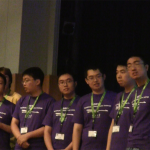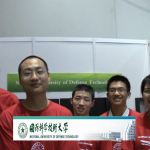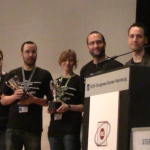The 2012 ISC Student Cluster Challenge ended last week, and it’s high time I write about the official announcement of the awards and analyze some of the results.
Each of the five teams put in months of work designing its cluster and learning how to optimize it to run the various benchmarks and application codes featured in the competition. They also had to stay on their toes, since the organizers were adding a secret ‘surprise’ application to the slate of apps to be run on Tuesday and Wednesday.
The award winners were announced at the closing ceremony on Wednesday afternoon. Gilad Shainer of the HPC Advisory Council, and overall organizer of the competition, acted as emcee. Short but inspirational addresses were given by ISC’s Thomas Meuer and Gerd Buettner from chief sponsor Airbus. The students were on the edges of their chairs as they waited out the program formalities in order to learn the results.
The first of the major awards was for the highest LINPACK score. It’s amazing how much difference six months makes when it comes to computer hardware. At the SC11 Student Cluster Competition in Seattle, six out of the eight teams broke the Teraflop barrier with scores ranging from 1.127 to Team Russia’s GPU-fueled high score of 1.926. And the year before, at SC10 in New Orleans, only three teams topped a Teraflop – barely.
But now, a mere six months later, all five ISC Student Cluster Challenge teams turned in Teraflop+ LINPACK scores. In fact, the lowest score this year would have finished in the top three or four last year in Seattle.
The high score, a stunning 2.651 TF/s, was turned in by China’s NUDT team. Their GPU-laden configuration paid off when it came to LINPACK: they left the rest of the field in the dust. It wasn’t unanticipated, however; most of the other teams believed that NUDT would probably take the LINPACK award once they learned that the Chinese had packed six NVIDIA Tesla cards in their bags.
The same can’t be said about participants in our betting pool. Most punters figured that home team KIT or the visiting Stony Brook Seawolves would come out on top in LINPACK. Had they backed up those sentiments with real money, they’d be counting their losses right now. On the other hand, anyone betting on NUDT would see their sagacity rewarded at a rate of 8 to 1. Not bad at all.
Still, you have to hand it to KIT. With their traditional CPU-based cluster, they came within 12% of hitting NUDT’s GPU-accelerated score, which is definitely something to be proud of.
In addition to LINPACK, the teams had to run a set of other HPC applications including:
- OpenFOAM, a computational fluid dynamics package
- CP2K, an atomistic and molecular simulation app
- CPMD, a molecular dynamics app
- NEMO, for oceanographic research and modeling
There were also two secret applications dropped on the teams each morning of the competition. Tuesday’s surprise app was WRF, a weather forecasting package, followed by GROMACS on Wednesday. GROMACS is a molecular dynamics package that simulates Newtonian motion equations on hundreds of millions of particles. Students were given data sets for each application and submitted their fastest run-times for scoring.
This competition was a series of sprints, with some of the apps taking only seconds to run, which gave the teams time to change tuning parameters in an attempt to get a better time.
The team LINPACK scores were combined with results from application runs and a round of team interviews to arrive at a final score used to determine the Overall Award winner.
The winner of the Overall Award this year (or as I’ve dubbed it, the Kluster Kup) was Tsinghua University, the other team from China. Their win was very broad-based. They topped all of the other teams on almost all of the application runs; they were topped only by KIT on one of the CPMD scores and NUDT on NEMO (and LINPACK too). Tsinghua also took top honors in the interview category, which is impressive considering that English isn’t their first language.
This puts Tsinghua in the position of having an undefeated (2-0) record in student cluster contests. In addition to their win at ISC12, they also beat five other teams in an intra-China play-in round that punched their ticket to the big dance in Hamburg.
NUDT was second in the overall competition, fueled by the big points they received for their dominant LINPACK performance and their second-place wins on four of the eleven application run scores. They also came in second in the interview portion of the competition. Home team KIT came in third overall, winning one of the applications and finishing a close second on three others.
But the kids from KIT scored a major prize, taking the Fan Favorite award in a close race with China’s NUDT. I think KIT’s efforts on the show floor put them over the top. They went from booth to booth meeting with and then lobbying show attendees for their Fan Fave votes. This strategy obviously worked, and also allowed them to gather an above-average haul of typical trade show swag.
There were plenty of awards to go around, and no one went home empty-handed. Stony Brook was given a special “Impressive Troubleshooting” award for their efforts in discovering and solving unrelenting hardware and software problems. The University of Colorado was recognized for being the first team to run every application, including the secret surprise apps – a testament to their depth and experience.
All in all, it was a very good student cluster competition. The organizers did a good job of making sure the logistics were in place and that everyone was well watered and fed. All of the students said that they enjoyed the experience and would like to do it again. We may see some of these teams at future ISC or SC cluster contests, although probably not at SC12 in Salt Lake City. (The slate for that competition is already set in stone, I think.)
What surprised me is how much mindshare the event achieved at ISC 12. I casually asked other attendees whether they were aware of the cluster competition, and almost all of them were not only aware but actively interested (but mostly not to the point where they were wagering on it).
It’s good to see the competition make such a big impact in its first year at ISC. I hope we see a renewed commitment from the SC folks toward their own version of the Student Cluster Competition; it was on the verge of waning after SC11 last year. Not because of the competition itself – it was the best yet, with eight very enthusiastic and skilled teams, a very close finish, and happiness all around.
But for some reason, the Powers That Be in the SC mothership figured it was time to shake things up and essentially drop the big iron competition. Thankfully, the decision was revisited and the ‘Cluster Classic’ will return to SC12 in Salt Lake City. More on this in later stories.
Maybe in the future the school winning the ISC competition would receive an automatic invitation to compete at SC, and vice versa. We would then witness the crowning of a ‘World Student Cluster Champion’ every six months – maybe even with a real crowns.
Posted In: Latest News, ISC 2012 Hamburg
Tagged: SC 2012, Student Cluster Competition, apps, LINPACK, NUDT, GPU, ISC 2012, Tsinghua University, KIT, University of Colorado, Stony Brook University, Airbus, HPC Advisory Council, CPU, Results



